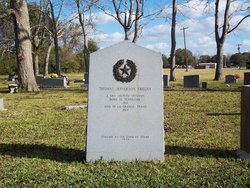SWEENY, THOMAS JEFFERSON (1812–1869).
Thomas W. Cutrer, Texas State Historical Association, Published: 1976.
Thomas Jefferson Sweeny, soldier and planter, was born in Nashville, Tennessee, on September 10, 1812, the son of John W. and Ann (Fuller) Sweeny. The family entered Texas on January 20, 1835. At Brazoria on August 9, 1835, Sweeny added his signature to a petition calling for a convention "to quiet the present excitement and to promote the general interest of Texas," and on March 25, 1836, he and his brother William Burrell Sweeny enlisted as privates in Capt. William H. Patton's Fourth Company-the "Columbia Company"-of Col. Sidney Sherman's Second Regiment, Texas Volunteers. The brothers served at the battle of San Jacinto, where William was on detached duty in Capt. Henry Wax Karnes's cavalry company. Thomas Sweeny was discharged from the army on June 6, 1836. William was murdered in Brazoria in September 1840.
In 1844 Sweeny married Diana Frances Haynie, a native of Knoxville, Tennessee. They had five children. In 1850 their Brazoria County property was valued at $4,140. In January 1851 Sweeny was involved in a legal dispute over the ownership of a number of slaves that was argued before the Supreme Court of Texas. By 1860 he was a wealthy planter with $32,000 worth of real estate and $43,000 in personal property, including thirty-nine slaves, in Brazoria County. The topsoil on his plantation is said to have been twenty feet deep. At the time he employed a full-time overseer and a tutor for his children.
Sweeny died at La Grange, Fayette County, in 1869 and was buried near the southwest Brazoria County community of Sweeny. His widow died in Angleton in 1904.
SWEENY, THOMAS JEFFERSON (1812–1869).
Thomas W. Cutrer, Texas State Historical Association, Published: 1976.
Thomas Jefferson Sweeny, soldier and planter, was born in Nashville, Tennessee, on September 10, 1812, the son of John W. and Ann (Fuller) Sweeny. The family entered Texas on January 20, 1835. At Brazoria on August 9, 1835, Sweeny added his signature to a petition calling for a convention "to quiet the present excitement and to promote the general interest of Texas," and on March 25, 1836, he and his brother William Burrell Sweeny enlisted as privates in Capt. William H. Patton's Fourth Company-the "Columbia Company"-of Col. Sidney Sherman's Second Regiment, Texas Volunteers. The brothers served at the battle of San Jacinto, where William was on detached duty in Capt. Henry Wax Karnes's cavalry company. Thomas Sweeny was discharged from the army on June 6, 1836. William was murdered in Brazoria in September 1840.
In 1844 Sweeny married Diana Frances Haynie, a native of Knoxville, Tennessee. They had five children. In 1850 their Brazoria County property was valued at $4,140. In January 1851 Sweeny was involved in a legal dispute over the ownership of a number of slaves that was argued before the Supreme Court of Texas. By 1860 he was a wealthy planter with $32,000 worth of real estate and $43,000 in personal property, including thirty-nine slaves, in Brazoria County. The topsoil on his plantation is said to have been twenty feet deep. At the time he employed a full-time overseer and a tutor for his children.
Sweeny died at La Grange, Fayette County, in 1869 and was buried near the southwest Brazoria County community of Sweeny. His widow died in Angleton in 1904.
Inscription
THOMAS JEFFERSON SWEENY. A SAN JACINTO VETERAN. BORN IN TENNESSEE. 1812. DIED IN LA GRANGE, TEXAS. 1869. Erected by the State of Texas. 1936.
Family Members
Advertisement
Explore more
Sponsored by Ancestry
Advertisement











